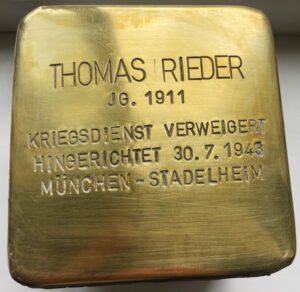Thomas RIEDER, born on September 26, 1911 in Saalfelden am Steinernen Meer and baptized Catholic, was the eldest of ten children of the married couple Johanna, née Hager, and Thomas Rieder, railroad and line attendants of the Austrian railroad.
The family lived in the small village of Pfaffenhofen on the railroad line between Zell am See and St. Johann in Tyrol.
Thomas RIEDER had neither a completed school education nor a learned profession. It is told that he had to work as a dairyman and milker in the Pinzgau mountains since he was eight years old. He lived there in precarious circumstances and remained unmarried.
He had no criminal record and his reputation was impeccable when, in August of the war year 1942 – before the draft order arrived – he went into hiding to avoid military service. He apparently got into an emergency situation, as he was committing thefts.
His escape, which lasted over eight months, ended with his arrest in Leogang on March 17, 1943.
Thomas RIEDER was a civilian, which is why he was not court-martialed like deserters from the German Wehrmacht, but rather before the »Special Court«, which was attached to the Salzburg Regional Court at the beginning of World War II.
Dr. Hans Meyer, chairman of the »Special Court« Salzburg, imposed twenty-six death sentences until his retirement in the war year 1943.
His last victim was the Pinzgau milker Thomas RIEDER, who was meticulously proven to have stolen clothing, food including crops worth 226 Reichsmark while evading war service – the robbery of conquered countries by the German Wehrmacht – for eight months.
Dr. Hans Meyer, Austrian jurist and National Socialist blood judge, used for his last death sentence on June 23, 1943, the wartime ordinances against »pests of the people« and »dangerous habitual criminals«, on top of that the »Ordinance on Special Criminal Law in War«, meticulously quoting § 5, paragraph 1, number 3: »Decomposition of the Wehrkraft«.
This included deprivation of military service.
It is strange that in the National Socialist public there was silence about the offenses of draft evasion and desertion. However, Thomas RIEDER, who was sentenced to death, was ostracized in the press as »Pinzgauer Almschreck«, »Volksschädling [Popular pest]«, »Gewohnheitsdieb [Habitual thief]« and the like because of alleged serial burglaries in alpine huts.
His testimony as a defendant remained unmentioned:
I have never done a burglary on an alp. I am not a habitual thief.
The National Socialist press also did not mention that Thomas RIEDER, at the age of 31, was beheaded with a guillotine in Munich-Stadelheim on July 30, 1943 – an execution that was meticulously recorded by the Munich Chief Public Prosecutor:
The execution process lasted 1 minute 12 seconds from the time he left his cell, and 12 seconds from the time he was handed over to the executioner until the axe fell.
The protocol does not record whether his body was buried anonymously in the Perlacher Forst cemetery or dissected in an anatomy. What cannot be overlooked, however, is how the weakest in society are dealt with: unscrupulously.
Thomas RIEDER’s family had tried in vain to obtain a pardon.
His younger brother Josef, who fought in the Spanish Civil War on the side of the International Brigades and was imprisoned in the Dachau concentration camp, survived the terror years.
Sources
- Documentation archive of the Austrian resistance: Court file with death sentence of the Salzburg Special Court (KLs 45/43).
- Bavarian Main State Archives Munich: Execution file (JVA Munich 576)
- Archive of the Archdiocese of Salzburg (matric books)
- Salzburger Zeitung 24. 6. 1943, p. 5
- Innviertler Heimatblatt 2. 7. 1943, p. 7
Translation: DeepL
Stumbling Stone
Laid 27.09.2022 at Salzburg, Kajetanerplatz 2



